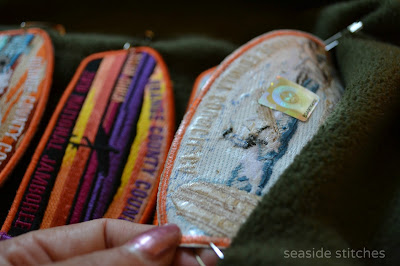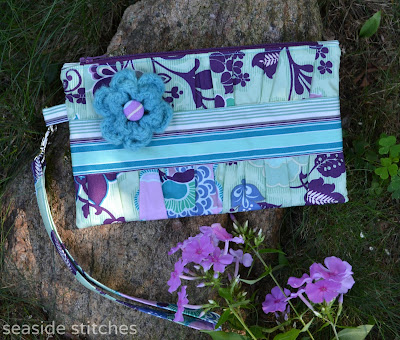As the mother of a Gold Award recipient and an Eagle Scout, I've sewn hundreds of patches on uniforms, blankets and tote bags.
In fact, I stitched 130 patches onto Pete's blanket last weekend. It was time to get the 2010 Jamboree patches out of that shoebox! This is what I learned...
Any scout mom or grandma knows that most patches are backed with a plastic-like stabilizer that seals in all the embroidery threads. That is not fusible web! It is almost impossible to stitch through by hand, so I use my machine. (There are some new iron-on Girl Scout patches, but I've seen many of them fall off. Add some stitches to be safe.)
I use a mono-filament invisible thread in the needle and a regular thread in the bobbin that matches the color of whatever I'm adding the patches to. You might need to loosen the top tension if you see too much of the bobbin thread coming up through to the front of the patch.
Choosing the right needle is a puzzle! I had Superior 90/14 topstitch needles on hand, but they were not strong enough. I liked the feel of the ballpoint needles on the fleece blanket, but again, the 100/16 needles snapped if I hit something they didn't like. I had the best luck with 110/18 jeans needles. I only broke one of those. It's a good idea to wear glasses or safety goggles to protect your eyes from flying broken needles!
Position the patches and use safety pins to hold them in place. If you can't get the pins through that awful plastic backing, tape them on, removing the tape as you go.
Drop your feed dogs and use your embroidery or free motion quilting presser foot. I bring the bobbin thread to the top so it doesn't make a knotted mess on the back. Start stitching, SLOWLY, around the patch. With the feed dogs dropped, you will need to move the patch/blanket under the needle. This way, you don't have to turn the whole blanket to get around the patch- think hula hoop motion. After you get all the way around, overlap the beginning about an inch before moving to the next patch. Lift the presser foot, slide the blanket over, and start the next patch. I trim all those connecting threads between patches later. If there are two patches abutting each other, you can just keep stitching.
Uniforms are a little easier. (That double layer of polar fleece was not my friend.) By free motion stitching, you can slide the sleeve onto the free arm of the machine and easily stitch around the patches.
In this closeup, you can see that I'm trying to stitch in that ditch where the satin stitching meets the patch fabric. That seems to be the point of least resistance.
I really try to avoid hand stitching, and I have been known to sew pockets shut by machine stitching pocket patches! In this case, I decided it would be nice to do it right, and hand stitched the Eagle Scout badge. That was a tiny pocket, because there is a pen slot on the left side, so it was hard to fit a hand in there to keep the pocket open. If you use something like a credit card or needle case inside the pocket, you can stick the needle in until it hits the plastic, and make your stitch without closing the pocket.
This is what happens when your son earns a patch at camp and sews it onto his dirty shirt by himself! His friend made fun of him for sewing the pocket shut. Haha!
When you are done, use hair elastics (hair ties, pony tail holders) to keep your thread neatly on the spool. This must have been a
Sew Many Ways tip, but I can't find it right now. We'll just give Karen credit for it anyway, because she's awesome!
I hope this helps some scout moms. Enjoy your time in scouting!

















































